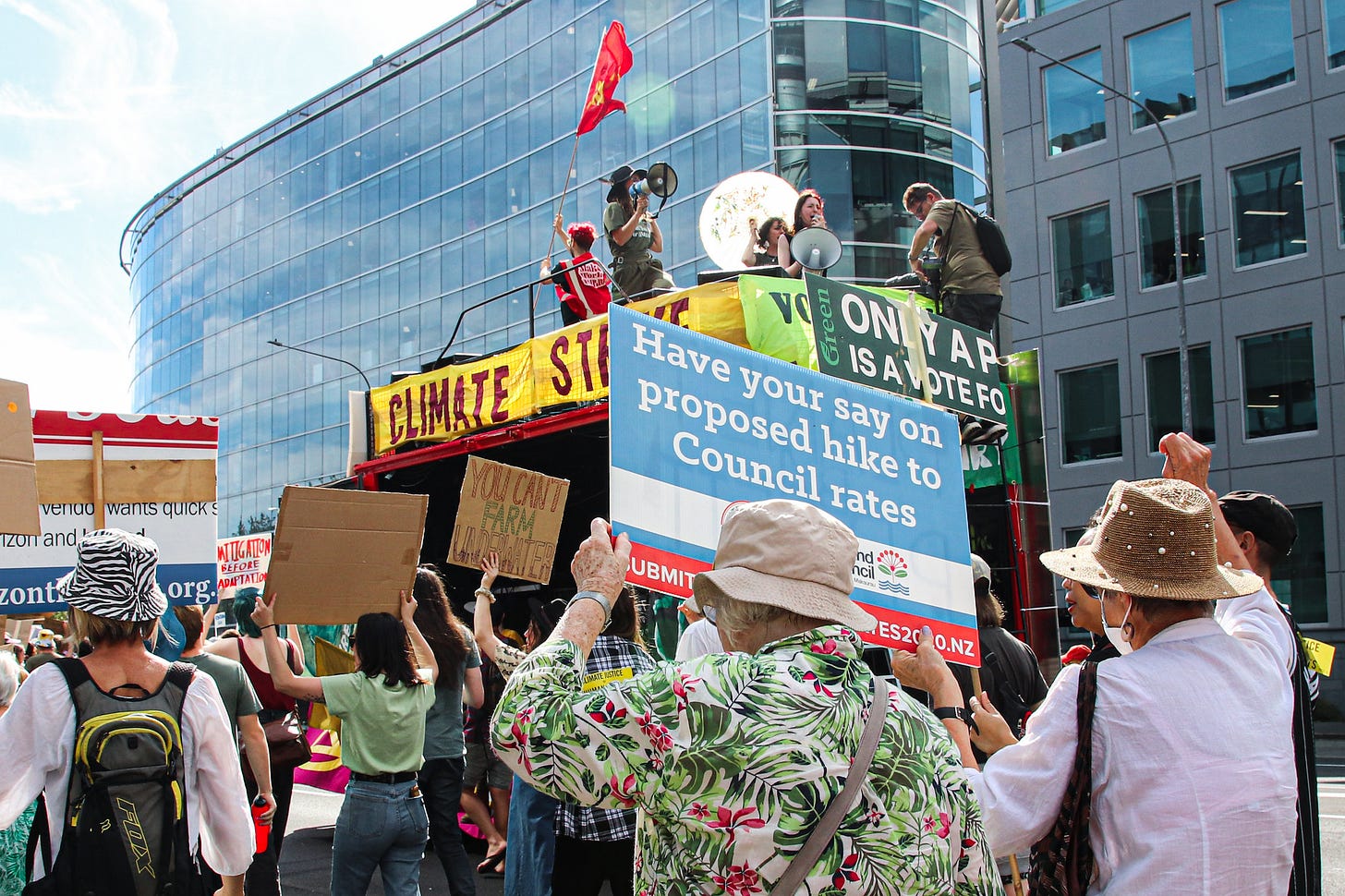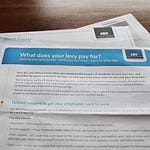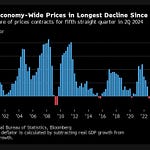
TLDR: Actually, there is an alternative.
The now-familiar ‘There Is No Alternative’ (TINA) narrative used by conservative governments and councils warning of debt blowouts and financial armageddon without budget cuts has been rolled out again in recent months by new Auckland Mayor Wayne Brown. It has barely been contested, but that’s changing now with the launch of the Better Budget Auckland group’s alternative budget today.
The group is proposing Brown and the Council abandon its plan to sell its 18% share in the Airport, that it increase borrowing by $75 million, and keep imposing a targeted climate and environment rate, rather than suspending it. It pointed out the borrowing could easily be afforded, even under an artificial self-imposed borrowing cap and with higher interest rates, and not cause a credit rating downgrade.
Rightly, Better Budget Auckland has called out Auckland Council’s cost-cutting in the immediate wake of covid stress and flood stress on Auckland’s most vulnerable communities as a political act, rather than an inevitable financial act.
What’s the background here?
This has been brewing since November last year when Brown pointed to a $295 million ‘Budget Black Hole’ to justify slashing all sorts of community services and spending on public transport and climate emissions reduction. The cuts include cuts to arts budgets, Citizens Advice Bureau and various transport upgrades, including cycling and walking infrastructure. Meanwhile, Brown has decided to ‘help struggling small businesses’ by suspending a targeted rate designed to fund climate emissions reduction.
Effectively, it’s the old tactic of cutting Government spending in a crisis and using the financial space created by those cuts to cut taxes. The waving of the ‘debt crisis’ stick helps justify the argument that there is no choice as the financial ‘weather’ is not something a council or councillors can change. It’s almost as if the decision is not political and there is no choice. TINA.
The equating of a government’s Budget with a household budget that needs to ‘cut its cloth to fit’ when revenues fall and economies contract is a familiar framing of the issue that resonates with…well…households and small businesses without access to bank debt or institutional investors who buy bonds (ie lend to large institutions).
‘The Government’s finances are just like yours’ (actually, they’re not)
Households who own their own homes and vote understand the logic of cutting spending in tough times and it’s natural they would like their elected representatives to share their pain. They don’t want ‘bureaucrats in cushy council jobs wasting precious and scarce resources’ at a time when many households are themselves heavily indebted and unable to borrow more. It’s an easy sell for most voters who don’t understand how Government and council finances work, or how financial markets work.
Anyone who has been paying attention to government bond markets globally, interest rates and Aotearoa’s financial markets for the last 30 years knows that the ‘Government as household’ trope is simply not true anywhere, let alone here, and is actually counterproductive when applied aggressively. Close observers also know that both the Crown and our councils are now both very lightly indebted and nowhere near breaching any debt or interest limits relative to their incomes and assets. If anything, their balance sheets are way, way too lightly geared. If they were private companies, they would be accused of having ‘lazy balance sheets’ by the shareholders and told to take on much higher debts and accept credit rating downgrades.
In effect, our Government and councils have run low tax, low debt and low interest cost finances for the last 20 years to create space for households to gear up for leveraged and tax-free gains on residential land. They’ve also skimped on infrastructure by not investing all the depreciation money set aside in their accounts every year, and not investing to keep up with population growth. From a purely financial point of view, our Governments have consumed their assets by not repairing or upgrading infrastructure, and have created future liabilities for themselves and others in the form of climate emissions liabilities and extra health, education and lost productivity improvement liabilities for the country at large.
Under-investing depreciation, under-estimating liabilities and ignoring public costs
They’ve gotten away with it because these liabilities either don’t land on their balance sheets or have not been properly measured by Treasury and the auditors who do the accounts of Governments and Councils. If the Crown and most of our councils were assessed in pure financial terms by auditors and shareholders, they would be accused of skimping on reinvestment to give their customers lower prices and creating regular non-cash financial losses because of the very-real liabilities being built up and not measured. A board of directors would fire the CEO and CFO and tell them to put up their prices, particularly if they were a monopoly with a legislated power to force customers to pay them every year, and to invest in their underlying asset base to reduce future liabilities.
But that is not a story you hear regularly. The framing of our Governments as dangerously indebted, wasteful and at risk of going bust rests on a very powerful origin story from the period from 1984 to 1991. Back then, the New Zealand Government was at times shut out of financial markets and suffered credit downgrades and interest cost blowouts, largely because New Zealand had a fixed exchange rate, no real domestic NZ-dollar denominated debt markets and borrowed short term in foreign currencies from banks and pension funds in the likes of London, Zurich and New York.
When New Zealand’s export receipts slumped and/or import costs rose sharply, there would be downward pressure on our currency peg and upward pressure on our interest rates, which often changed monthly at the whim of the bank or funds because the rate was set at a margin to variable wholesale rates. This toxic combination of short term foreign currency borrowing with a fixed exchange rate often rapidly turned into a foreign exchange and debt crisis as the cost of servicing the debt exploded whenever the NZ dollar was devalued at the same time as a rise in wholesale interest rates. The double whammy of having to earn a lot more foreign currency to service the same debt was often crippling. Back then, we lived in fear of an oil shock or a wool bust or a credit rating downgrade, and with justification.
That was then and now is nowhere near like then
But that was then. Not since the late 1980s and early 1990s have Aotearoa’s Government and Councils been in any danger of some sort of lender strike or withdrawal in which ‘bond vigilantes’ gang up to drive up interest rates and ‘punish’ Governments for being too indebted and profligate. That’s because the NZ dollar was floated in 1985 and the Government and councils have steadily been building up a local debt market ever since. It has meant that our Government and councils almost always borrow in New Zealand dollars through fixed interest rate bonds that effectively transfer any interest rate risk and currency risk to the investor. Those investors are now typically banks here, KiwiSaver funds or local pension funds.
When there’s an economic shock that pushes up market interest rates here and drives the currency down, the Government’s interest costs don’t immediately rise as a share of GDP. It doesn’t need to massively cut spending or increase taxes. That’s because the bonds are fixed interest bonds with ‘coupons’ that don’t change. They’re also denominated in NZ dollars, so it doesn’t matter if the NZ dollar is ‘devalued’ by the markets. It doesn’t force our exporters to work twice as hard to earn many more US dollars or pounds or francs to pay interest costs that just surged because the debt was set at variable rates.
So what? Isn’t the debt still dangerously high still? No. It’s way less.
The ability to borrow with fixed interest rates in New Zealand dollars isn’t a get-out-of-jail card for Governments. If their debt-to-tax-revenue or interest-cost-to-revenue ratios were too high, then the debt would still get downgraded by ratings agencies and interest rates would rise sharply. They wouldn’t immediately hit the public finances, but it would mean that future bond issues to refinance debt or further increase debt would be more expensive at the margin, and in an extreme situation would make new borrowing impossible and force an immediate and painful repayment of an maturing bond issue.
So how indebted is our Government and our councils and the Auckland Council in particular? The best place to look is the rating agency reports and the updates from the Local Government Funding Agency (LGFA). They are designed for the pension funds and banks who have to lend their hard-earned money to the Crown and councils. These are the hard-nosed professionals who are paid to be careful and know whether there is a risk the Crown or council won’t pay the interest or repay the bond in full.
So what do they think? And most importantly, what were they thinking and saying in November last year when Wayne Brown waved the ‘budget black hole’ stick at ratepayers, council staff, councillors and the various service providers he wanted to sack. Firstly, here’s what Brown said via a statement on November 24 shortly after the Reserve Bank warned of higher interest rates the previous day:
“Yesterday’s Reserve Bank forecasts have blown out Auckland Council’s 2023/24 budget hole to $295 million, Mayor Wayne Brown and his Governing Body have been advised today.
“Left unaddressed, a $295 million budget hole would require rates rises of over 13 per cent, followed by further substantial increases in future years,” Mayor Brown said. It is by far the biggest fiscal hole in Auckland Council’s history, except for the once-in-a-hundred emergency budget when our city was put into lockdown.
“Double-digit rates rises are totally unacceptable and will not happen under my leadership.” Wayne Brown via a statement on Nov 24
So how were the professionals feeling about the black hole in late 2022?
S&P issued a glowing report about Auckland Council just beforehand
Here’s the headlines from Standard & Poor’s semi-regular report on Auckland Council’s credit rating that it issued just a few weeks prior to Brown’s statement:
“Auckland Council's after-capital deficits are narrowing over our forecasts as the New Zealand local government's revenue growth outpaces expenditure. This should stabilize debt levels.
“The council's strong economic and liquidity profiles, experienced management, and New Zealand institutional rating underpin our rating.
“We are affirming our 'AA' long-term and 'A-1+' short-term issuer credit ratings on Auckland. The outlook is stable.” Standard and Poor’s report on Auckland Council
The expert is saying that Auckland is not only in a good position with a gold-standard AA credit rating, but its position is solid enough to put a stable outlook on the rating. I’ve been reporting on these sorts of credit ratings for 30 years. It’s only when they start putting a borrower on ‘negative outlook’ and downgrading ratings that people should start to worry.
But wait, there’s more. S&P actually said there was a chance it could upgrade…yes upgrade…Auckland’s credit rating if Three Waters goes ahead and, as it expects, Auckland’s population and economy continues to grow quickly and the central Government keeps helping fund infrastructure.
“In our view, revenue growth as the economy opens up will help mitigate cost pressures arising from higher inflation. The council will post moderating after-capital deficits in 2023-2025, limiting debt accumulation.” S&P reported.
It also took into account the recent inflation of costs and noted the Councils deferral of some infrastructure spend would help, along with the targeted climate rate.
Auckland's budgetary performance is improving. We forecast the council's after-capital account deficits average has lowered, to about 9% of total revenues between 2021 and 2025, from 12% between 2020-2024. However, an immediate squeeze on the council budget persists. COVID-19-related impacts on council revenues, including slower reopening of services, reduction in fees and charges, and lower dividends are persisting longer than the council anticipated. Likewise, current economic conditions, including rising interest rates, inflation, and labor market tightness are driving up costs.
The council's immediate response to short-term budgetary pressures leaves it well-placed for a swift recovery. The council is deferring NZ$230 million of small-scale capital expenditure over the next three years and reducing lower-priority service offerings from fiscal 2023. The introduction of a new climate action targeted rate will raise an additional NZ$57 million per year on top of planned rates increases of 3.5% per year. S&P report
So what if Auckland’s finances were compared to a household’s?
There’s another test of the Council’s need to cut costs. How indebted is it relative to its assets and income, and what are its borrowing costs relative to income. Remembering that most renting households and those with big mortgages are routinely spending more than 30% of their income on debt servicing and mortgages, it’s worth knowing the Council’s interest costs are around 10% of its income. Its debt is expected to be $13 billion by 2024/25, which is around 240% of revenues and down from around 260% this year.
Remember that a lot of first home buyers are borrowing 500% to 600% of their income. Another comparison is the loan to value ratio. Auckland had assets valued at $72.73 billion as of the end of December, while its total borrowings of $11.75 billion at the end of December represented a loan to value ratio of 16.1%.
Just imagine if you said to a first home buyer that your debt was costing 10% of income to service, was barely 2.5 times your income and the mortgage had an LVR of 16%. What do you think they would say? That Auckland’s debt is so bad that it needs to cut spending on essential services and launch a fire sale?
Elsewhere in the news today…
Listen to this episode with a 7-day free trial
Subscribe to The Kākā by Bernard Hickey to listen to this post and get 7 days of free access to the full post archives.












